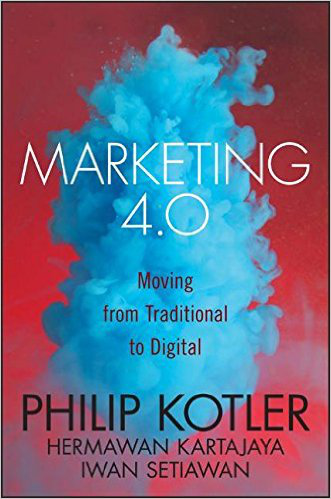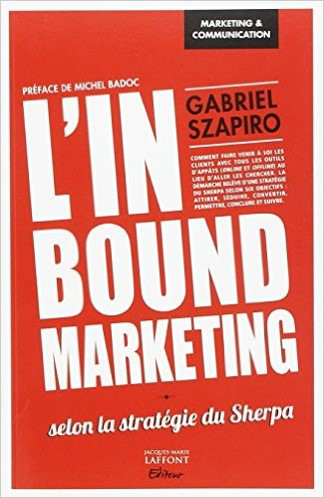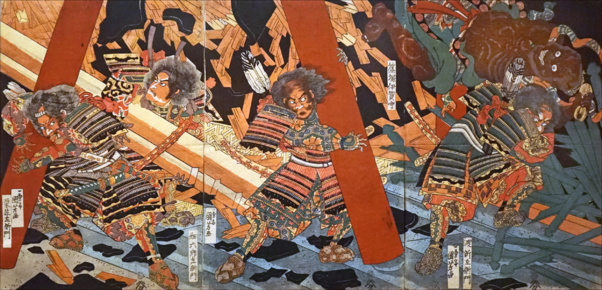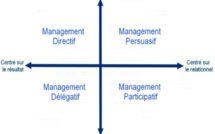If you consciously try to thwart your opponent,
you are already late. Miyamoto Musashi*
Sen-no-sen is good because it gives you room.
* Gorin-no-sho.
you are already late. Miyamoto Musashi*
Sen-no-sen is good because it gives you room.
* Gorin-no-sho.
The Japanese archipelago has no territorial depth. It suffers constant threats from seismic activity and tsunamis coming from the Pacific Ocean. For a long time, it did not consider itself as belonging to Asia nor to the West, but Japanese and unique! Because lack of physical space limited the liberty of action [1] of people and organizations, Japan found ways by mastering sophisticated intense and short rhythms based on full commitment to the here and now, devoting total attention to the present as budo (the art of samurai) or Buddhism recommend. Throughout its history, Japan’s first defense line, i.e. the sea, preserved it from decisive invasions from abroad till the arrival of U.S. Commodore Perry’s black ships in 1853. Faced with the ultimatum of opening the country or being militarily compelled to, Meiji Emperor referred to and mobilized specific roots of Japanese culture, the martial ones of budo, the way of samurais, leaving which one was prevailing during the peacefully previous Edo period (1600 / 1868).
Due to the lack of natural resources, the search and exchange of information are taught early to children, all along to community’s belonging and surviving interdependence. By necessity, no ways outside the group! Each one gives his-her best for the sake of the whole. In Japan, human resources and increasing capabilities represent major means for survival and development. The country used to import from overseas many skills, crafts, philosophies, religions, writing, technologies… and then applied, transformed and improved them to such a point that they became able to be exported. Although the print of Chinese civilization influenced Japan so much, its unique culture of strategy plays a major role in the way the country faces issues and challenges, both historically and by now.
Due to the lack of natural resources, the search and exchange of information are taught early to children, all along to community’s belonging and surviving interdependence. By necessity, no ways outside the group! Each one gives his-her best for the sake of the whole. In Japan, human resources and increasing capabilities represent major means for survival and development. The country used to import from overseas many skills, crafts, philosophies, religions, writing, technologies… and then applied, transformed and improved them to such a point that they became able to be exported. Although the print of Chinese civilization influenced Japan so much, its unique culture of strategy plays a major role in the way the country faces issues and challenges, both historically and by now.
The culture of strategy as an art of setting up a community
able to survive through its relationships
and use of space, time and alterity
able to survive through its relationships
and use of space, time and alterity
Throughout history, cultures of strategy appeared and spread as the result of specific efforts within specific conditions to set up human communities that last and adapt themselves within their respective environments when facing adversity. A culture of strategy results from a set of experiences and intellectual heritage teaching how to survive and to achieve goals. When people face dangers and threats, they refer to their own culture of strategy to shape and implement creative adapted solutions. As a kind of ethos, it gathers a specific vision of the world, a set of behaviors, habits and attitudes, spontaneous ways of thinking and acting as regards conception, organization and use of ways and means to achieve goals by necessity or deliberate choices.
The physical characteristics of countries shape cultures of strategy. Scales influence the way time is represented and used. Let us consider some examples. A large and deep country like Russia may lose space temporarily to gain time [2]. On the contrary narrow coastal nations like the Netherlands, Portugal or Kuwait used to develop alliances with hegemonic ones [3] to protect them from their powerful neighbors [5]. A country like China bought space with time. Acculturating their Mongol and Manchu conquerors [4], it expanded sovereignty above them within a few centuries. History with its tragedies, successes and reflection about them contributes to shape cultures of strategy and their successive adaptations, growths or declines. The ways time and rhythms are represented and experienced within the diversity of cultures also distinguish them.
The North-American anthropologist Edward Hall [6] introduced the concepts of monochronos cultures in which people used to do just one thing or one task at one time, and polychronos ones in which people need to assume various tasks simultaneously. It is easy to deduce its influence on strategy. Religions, beliefs, social values and political organizations also contribute to shape cultures of strategy. Nevertheless, each of them may learn, get inspiration and enrich themselves from others.
Within an open and interdependent world in which interactions between actors and organizations from different cultures are dramatically on the increase, being aware of the specificity of one’s own culture of strategy sounds as an imperative for nations and organizations, including firms. Getting insights and understanding about other cultures of strategy is not just a matter of possible efficiency in mastering relationships but also a way to deepen self-understanding by contrast, and also to be enriched and stimulated. If not, the “other” would always be considered as an alien, definitively strange, ill-mannered, uncultured or barbarian and quite unable to live in a civilized world, i.e. the one defined by the self! As a result, such an attitude fosters deafness and blindness toward the wide diversity of others but also toward ourselves!
The strategic stand back principle is based on acceptation of diversity, which introduces to the possibility to consider and analyze different peoples’ modalities of action and strategic attitudes, which are coming from elements of continuity from their own histories [7]. The North-American anthropologist Edward Hall [6] introduced the concepts of monochronos cultures in which people used to do just one thing or one task at one time, and polychronos ones in which people need to assume various tasks simultaneously. It is easy to deduce its influence on strategy. Religions, beliefs, social values and political organizations also contribute to shape cultures of strategy. Nevertheless, each of them may learn, get inspiration and enrich themselves from others.
Within an open and interdependent world in which interactions between actors and organizations from different cultures are dramatically on the increase, being aware of the specificity of one’s own culture of strategy sounds as an imperative for nations and organizations, including firms. Getting insights and understanding about other cultures of strategy is not just a matter of possible efficiency in mastering relationships but also a way to deepen self-understanding by contrast, and also to be enriched and stimulated. If not, the “other” would always be considered as an alien, definitively strange, ill-mannered, uncultured or barbarian and quite unable to live in a civilized world, i.e. the one defined by the self! As a result, such an attitude fosters deafness and blindness toward the wide diversity of others but also toward ourselves!
Because it requires distance and contextualization, a comparative cultural approach of the variability of cultures of strategy reveals and balances strengths and weaknesses of the self and of the others. It represents a condition of understanding others both in cases of competition or of association, so it opens possible mastery of interaction of wills [8]. This approach of diversity is not just a source for enlightenment and enrichment but also for efficiency. Taking into account the cultural roots of strategy and the ways they flourished and developed in Japan, does not mean all Japanese enterprises and organizations act in a similar way, following the model of Medieval Japan with clans and samurais fully devoted to their daymyo (clan leader).
A culture of strategy represents a backdrop, a set of references, spontaneous attitudes, ways of thinking, to conceive and to plan action and interactions of wills within time and space. It impregnates and feeds people’s imagination the way Ancient Greek mythology, real or fictional emblematic stories like Cyrano de Bergerac in France, King Arthur in Britain or Miyamoto Musashi’s saga in Japan do. In the U.S., the Frontier Myth [9] still acts as a powerful reference within North-American minds and still shapes policies and strategies. The belief of being the elected nation in charge of fostering civilization and liberty against wilderness and non-development acts as a driving force that led the U.S. to the moon… The 20th century French commix of Gaul Asterix and Obélix who were supposed to live in a unique tiny independent village while all Europe was ruled by the Roman Empire [10] acts as a symbol, an archetype of the fierce resistance of specificity against uniformity (globalization). The principle of “exception culturelle” which defended French culture and cinema against the commercial hegemony of Hollywood, followed this Asterix and Obélix pattern. A culture of strategy gathers spontaneous attitudes, characteristics and trends far more tacit than explicit. It provides a kind of economy of action because people belonging to the same culture do not need to discuss so much about options and ways to conceive and to take action. Nevertheless, when it comes to acting worldwide through interaction with other cultures, it might represent an obstacle because of lack of contextualization and critical distance.
In the case of Japan, the sea always established an obvious distinction between the ones living within the limits defined by the Japanese coasts on the one hand, and all the non-differentiated rest (gaijin) living overseas on the other hand. Mainly all cultures from archipelagoes and islands know about this clear difference between “we” and “them” (U.K., Cuba, Sicilia…). So, it is possible to identify similarities among islander cultures of strategy: in the ways they consider themselves and others, ways to seek, to use, to search and to exchange information and a kind of expeditionary spirit against continental people and countries… On the periphery of Asia, Japan is Japanese above all! Nevertheless, if the sea acts as a natural protection, the islands face high vulnerability if this protection comes to be penetrated. This led British kings to declare their enemies’ coasts as the effective kingdom’s frontiers and to assume maritime dominance (Sea Power).
Apart from logistic skills, insular nations set up intelligence services in order to face the handicap of distance to cross and to gather information about continental powers. Launching an expedition out of an island supposes efficient previous assessment about what is required to be embarked and to be disembarked when and where the continent is reached. Knowledge about conditions of navigation and disembarkation has to be sought! From a strategic point of view Islanders are more nomad than sedentary, more hunters than preys, deliberately offensive rather than defensive. As a result, a “culture of information” appears as an imperative for people from archipelagos and islands.
To consider the outside, Islanders are more moved by a strategic (global) spirit than by a tactical (local) one. There are no limits on the seas and oceans that provide entrances to all the countries as Cardinal Richelieu [11] used to stress. In such a wide area in dispute [12], movement and initiative belong to the ones who are faster and invisible, and who are able to strike when and wherever they choose as long as they cannot be identified. So, secrecy is also a spontaneous necessity in islanders’ cultures of strategy. Therefore, they need to master and to control the maritime element and this may lead to exclude competitors. Gaining liberty of action through efficient economy of means [13] allows Islanders to seize and keep initiative while Continentals are driven to stay defensive everywhere. As did Great Britain once unified, after the Meiji Era Japan turned to the continent in a conquering way.
Apart from logistic skills, insular nations set up intelligence services in order to face the handicap of distance to cross and to gather information about continental powers. Launching an expedition out of an island supposes efficient previous assessment about what is required to be embarked and to be disembarked when and where the continent is reached. Knowledge about conditions of navigation and disembarkation has to be sought! From a strategic point of view Islanders are more nomad than sedentary, more hunters than preys, deliberately offensive rather than defensive. As a result, a “culture of information” appears as an imperative for people from archipelagos and islands.
To consider the outside, Islanders are more moved by a strategic (global) spirit than by a tactical (local) one. There are no limits on the seas and oceans that provide entrances to all the countries as Cardinal Richelieu [11] used to stress. In such a wide area in dispute [12], movement and initiative belong to the ones who are faster and invisible, and who are able to strike when and wherever they choose as long as they cannot be identified. So, secrecy is also a spontaneous necessity in islanders’ cultures of strategy. Therefore, they need to master and to control the maritime element and this may lead to exclude competitors. Gaining liberty of action through efficient economy of means [13] allows Islanders to seize and keep initiative while Continentals are driven to stay defensive everywhere. As did Great Britain once unified, after the Meiji Era Japan turned to the continent in a conquering way.
The origin of the Japanese culture of strategy refers to the medieval era of the archipelago. The symbol of the samurai, a devoted warrior, appears as its emblematic figure as the mandarin, a civil servant and political literate person, appears as that of traditional China [14]. Two main treaties are considered as the basis for the understanding of the Japanese way. The first one: Gorin-no-sho, or “Treaty of the Five Wheels” [15], was written by the famous ronin Miyamoto Musashi more than three centuries ago. According to the legend, Musashi gained victory through sixty fights to death and then turned towards meditation. The second: Hagakuré, literally "Hidden among the leaves", was written by a samurai who became priest: Tsunemoto Yamamoto [16]. Both books are available in Western languages.
If Gorin-no-sho constitutes a reference fully acceptable and accepted in contemporary Japan, Hagakuré with its absolute and fundamentalist dimensions still calls to mind extreme evocations from Japanese imperial militarism. The list of the commentators of both texts is impressive. One of the most famous about Hakakuré is the novelist Yukio Mishima who committed suicide ritually after having vainly tried to raise the Japanese self-defense forces in 1970. The translation of the text of Musashi (Gorin-no-sho) by the North-American Thomas Cleary is an authority on the subject. In France, the book
In his fundamental and emblematic text, Yamamoto declared that facing the extreme dilemma of life or death, the warrior who thinks about survival would never mobilize the totality of his means and will. This fatal attitude is not just unforgivable, but limits action and reduces operational capability. On the other hand, thinking about dying leads to full commitment, to the greatest output that goes far beyond self-limits and capacities. Compelled to choose between life and death, choose death without any hesitation, declared Yamamoto! Roughly three centuries later, in his comment of the text, Yukio Mishima stressed that death is an excellent adviser and the best assistant in the samurai’s way (“do”). Therefore, Hagakure recommended daily meditation on death, so as a result it leads to be fully concentrated on life!
Readiness to death at any moment of the day, keeping this thought in mind enlightens life permanently, making it vivid and full of meaning. (…)
But such a sacrifice supposes the existence of a strong and effective community, which perpetuates the nobility of this spirit [18].
But such a sacrifice supposes the existence of a strong and effective community, which perpetuates the nobility of this spirit [18].
By its origin in the way of the warrior, the Japanese culture of strategy differs from the Chinese one, more twisted and cunning [19], political and focused on duration. Maintaining energy and equilibrium in the Chinese culture might give light to tortuous combinations and stratagems in the long run. On the contrary in Japan, the culture of strategy appears mainly as a philosophy of action in which subjectivity and devotion constitute prior values. Following the own words of Yamamoto, Mishima stressed pure instinctive sincerity, which leads directly to an ideal one can die for without any hesitation! Hagakuré’s philosophy made action the most efficient means to escape from the ego’s limits and to participate in a wider unity.
The importance of harmony to match with the whole and to participate as part of the universe is profiled as the ultimate goal to achieve in Japanese “do”. Mishima denounced with a rare virulence Western humanism whose pretended universality masks, according to him, both subjective weakness and inconsistency of ego. The calculation spirit that is at the base of rationalism, Mishima wrote, just leads to consider death as a debit and life as a credit. On the contrary, budo teaches the most intense concentration so that vigilance can never be put at fault. According to the philosophy of Zen Buddhism, the end is contained in the means, the goal lies in the way [20]. Only the present exists. Nishida wrote: We do not intuit the past; to feel something is past is a feeling in the present [21]. Therefore, Yamamoto considered that now is the moment and the moment is now. There is no distinction between the quality of one particular moment compared to another. Training, meditation like the most ordinary daily action has as much importance as a fight in which death or life are at stake. One has to be right at each second of his-her life and reality has to be faced without any states of mind.
Resistance, enemies as much as evolutions or constraints of environment, far from being occulted or denied, represent a source of improvement, a leverage for progression and permanent bettering. Obstacles, difficulties and dysfunctions are recognized, studied and respected, even sought, because their absence or lack of consideration would mean no possible improvement, no “do”! Any individual or collective actor is fully responsible for failure or success and no excuses or moods can be taken into account. A daily intensive vigilance results from this attitude and commitment. Because nothing of what is perceived is neglected, Japanese people excel in the treatment of weak signals [22] in order to produce strategic knowledge.
For Michel Random, the way (“do”) consists in ensuring the control of the center. The center is stability and harmony. Accuracy comes from harmony (“wa”) with the whole. This leads to sincerity and erases the interpretative distortions resulting from the pregnancy of ego. Achievement of harmony comes from the central point hara. Who occupies the center unites him-herself with nature. Doing so, he or she becomes invincible because how to struggle against nature itself? During a fight, the one who survives is the one who maintains harmony with the circumstances by remaining concentrated on his-her hara. From it comes everything, toward it turns over everything (…) Great simplicity always results from harmony that is coming from intense self-presence never absorbed by distraction nor concentration itself [23]. A combat manifests truth in bright light and reveals who deserves to survive and who to disappear.
In other words, who is in harmony with the environment and who did not read the evolutions of unfolding conditions and, as a consequence did not adapt him-herself. That supposes a permanent work, independently of the occurrence, or not, of situations of conflict. As the Chinese Sun Tzu [24] wrote, the issue of a fight just manifests what preexists. A duel is first gained in spirit that is to say in an invisible way. Only the invisible is Japanese, answered Yukio Mishima to Michel Random while the latter was asking him about the reason for the presence of only French pieces of furniture in his apartment. For Mishima, budo spirit and the essence of Japan are widely upstream of what could be seen with the eyes and listened to with the ears.
Gazing at the moves of the golden carps in the pond,
the wise man detects the earthquake soon to come.
the wise man detects the earthquake soon to come.
The Budo attitude induces such a participative communion with reality that it reduces in a drastic way the duration between the occurrence of a sign, its perception and the adequate reaction to it. Just like the sensitivity of golden carps makes them capable of expressing the signs that the wise man perceives within his body, Japanese culture recommends to act accordingly to the perpetual change of circumstances. Gazing at the transformation of leaves’ colors, ikebana, the tea ceremony or even martial arts provide opportunities to match, to go along with change and to maintain harmony through “do”.
Training without slackening educates the sensitivity to the point of making it perfect. This state of perfection sounds impossible to reach on Earth within Western traditions because it is considered as God’s exclusive matter [25]. Nevertheless, it exists in Japan through the statute of live treasure (“ningen kokuho”). A Nippon craftsman whose lacquer is irreproachable, and who reaches perfection in his art, is likely to be declared live treasure by the Emperor. So, perfection is not located in a faraway transcendence going beyond or in a hypothetical life beyond death but is carried out when the individual’s will no longer personifies an obstacle against the work of nature. No personal viscosity interferes nor slows down natural harmony.
Ueshiba Senseï, the creator of aikido, taught his disciples that whoever wanted to attack him, attacked nature itself! So how to strike against natural laws themselves? Awaza Sensei, with whom the German Eugen Herrigel studied kyudo, the traditional art of archery, reported that it was not he who strung the ark, who adjusted the arrow to aim the target. Something used to draw it through him [26]. The arrow was literally attracted by the target because no difference existed between them, no separation between past, present and future within the reality of the instant. The right gesture appeared as an effect of pure transparency of the archer’s will with the environmental conditions. Releasing his own particular and isolated will, narrowly focused on an objective, the archer transforms himself into a vehicle of pure flowing energy governed by harmony. Paying too much attention to the edge of a sword vampires energy and weakens the one under threat while increasing the energy of the other.
Any intention in itself may be an intermediate goal that alienates the ultimate one (…). What effectively is, just asks to burst out and to flood out like an arrow or a sudden reality [27], as a natural necessary gesture without the slow down filter of any personal will.
When the goal is not distinct from me, I can see the arrow reaching the target before the blow itself [28]. The task consists in leaving things be, without slowing down nor detaining anything. One finds this philosophical attitude of immediate presence and action in some Japanese companies, which aim to feel the conditions and the changes of the markets upstream, i.e. in the invisible, in order to conform and to adapt accordingly. As stressed previously, the physical characters of Japan influence its culture of strategy in its sense of anticipation.
For centuries, the lack of space was compensated by the capability of acting within precise micro-rhythms. Because space deprives one of margins to move, the palliative consists in finding ways combining knowledge, skills and sensitivity to take the slightest time opportunity when it manifests itself. To do that, intuition has to be trained intensively. Such perspicacity allows an actor, individual or collectivity, to act when the future is to come with the accuracy of a surfer marrying the wave at its birth. The strategy of anticipation is prospective. It acts on change and structures forces and means through innovative concepts, new managing principles, brand models or values that strengthen the group’s cohesion and human determination [29].
When rhythm dominates, action is right.
In Japan, space is so carefully organized and time so efficiently divided and subdivided that it provides space! The concept of rhythm is central within Japanese strategic culture. Musashi in its Gorin-no-sho recommended identifying it everywhere. One might observe it in the search for fluidity in the enterprises’ atmosphere in Japan. Rhythm ensures harmony within communities and fosters efficient operational coordination. It is necessary to distinguish between the upward rhythm and the declining one. Knowing the concordant rhythm allows to conceive the contrary one. It is of the upmost importance to distinguish between the rhythm, which matches well, the rhythm to be seized according to opportunity and the opposing one. Narrow or broad rhythms, slow or fast are characteristic of the tactics. When the opposite rhythm is not seized, the tactics will have no solid bases.
Musashi recommended the empty rhythm, born from intelligence, and which appears as unexpected by the enemy. To seize the rhythm of the opponent, one has to develop aptitude to put him-herself completely in the opponent’s place in order to overcome his-her intentions before they come to reality! Above all, initiative has to be kept, unceasingly taking the rhythm of the adversary with an opposite course and by modifying tactics as much as necessary till victory is achieved [30]. Permanent reference to face-to-face duel, gives a tactical, even operational connotation to the Japanese culture of the strategy.
The way (“do”) of the advantage in all things is the subtitle of Gorin-no-sho of Miyamoto Musashi. It gives a whole set of tactical recommendations for combat according to the estimation of the levels and qualities of the opponents. Several forms are possible: sen, go-no-sen and sen-no-sen. Their choice depends on the balance of competences and skills between the protagonists and on the capacity to act within more or less short rhythms. Sen techniques, or direct ones, are based on the mastery of one skill, aptitude or original capability that can make the difference in a face-to-face engagement. In the field of economic competition, it can be provided by a specific technology, an innovative concept, a unique method or a particular skill, which makes the difference.
According to Bernard Nadoulek, the use of this kind of trump has limited effectiveness because opponents always strive to identify it, to copy and to better it, so that the initial advantage might turn into weakness. During a fight, its success often results from sudden initiative or surprise that achieves the decision quickly. On the other hand, counter techniques called go-no-sen [31] are to be chosen preferably when the protagonists are on equal level or when the opponent is superior in skills and capabilities. Increasing physical distance (“ma-ai”) between protagonists and putting oneself relatively out of reach might induce the opponent to step forward first inside the interaction space unveiling his own intentions through action. Then, it becomes easier to act accordingly, to counter because of the trap where the opponent has fallen or to lead and conduct his revealed move. Such tactics refer to what is called the second player strategy. After World War II, Japan chose this strategy for its own rebuilding. While winners conceived and developed innovative technologies, the country concentrated on the systematic improvement of products to take future advantage and initiative whereas competitors had consumed the main part of their resources and creative energy. This go-no-sen strategy made possible industrial counter-attack at a time when the others were off balance or resting action. As a result, go-no-sen techniques match and add the strength of the opponent that of the self because of the latter’s mastery of rhythm.
Lastly, the very Japanese techniques of sen-no-sen, or initiative within initiative, may represent the best, and eventually the worst, in Japanese culture of strategy. They incorporate a simultaneous combination of intuition, prediction, insight and movement associated with a limitless determination. Keep the will of crossing the critical current in the moments of crisis, recommended Musashi while insisting on the constant importance of seizing the initiative. Once critical currents are overcome, weak points in the adversary’s situation appear and give birth to opportunities for rapid initiatives.
The critical current could be represented by the katana’s course under which one has to step voluntarily: entering within the adversary blow but moving quicker away from the future impact point. Referring to Musashi, two contrary rhythms-moments can be seized. The first is positive and direct using anticipation (“omote”) and the second is negative taking advantage of the engagement of the attacker (“ura”). When the sword (“ken” or “katana”) is filled with accumulating energy, it simultaneously provides emptiness in the opponent’s defense where it becomes possible to attack (“omote”). In the second case, while the sword is brought down, gathering momentum to strike with the maximum of energy, there is a tiny moment when and where the course can no longer deviate from the initial location of the target.
So, the tactic consists in acting faster in order to put oneself aside (“ura”) side-stepping the one who strikes, and once facing the same direction it becomes possible to take the lead… Sen-no-sen requires the highest and fastest capability of acting within the opponent’s moves: halfway before he is ready to strike, halfway before he reaches the target [32]. One can identify sen-no-sen strategies when firms try to market a quick succession of products or services to overcome competitors’ rhythms. In Japan sen-no-sen is good, because it gives you room! Though, immoderate or systematic use of sen-no-sen may lead far beyond the center or raison d’être of an organization, so that contact may be lost with reality. Without vision and proper orientation, extreme mobilization or fanaticism is without useful result. But these techniques reveal themselves as excellent when they are well informed and coherent within a strategic framework to achieve goals. Relying on intensive training and rhythms, sen-no-sen is a way to provide space and opportunity where there seemed to be no possibility at all.
Another core concept of the Japanese strategic culture is the one related to Chinese philosophy. The management of relationships appears essential, not just inside an organization but also with competitors or partners, and more broadly with the environment itself according to the change of circumstances. In aikido, teaching focuses on the work of the one who undergoes a technique (“uke”) from the one who applies it (“tori”). Uke should never give up but has to follow the tide actively till the very moment when the technique comes to its climax, so uke becomes able to reverse the course, transforming him-herself into a tori. Matching the movement and maintaining harmony, initial uke seizes the initiative from the inside of the move he is following thanks to his practical intelligence. However, such accuracy relies on permanent training of one’s sensitivity to the unfolding conditions and requires open-mindedness, availability non-perverted by a priori or ready-made models that would shape and restrict consciousness and perception.
Within sudden action there is a specific moment situated between life and death, and it is called instant. Instant is out of time. Simply, it is. Instant represents what exists as eternal in mankind and in anything. The warrior gets used to being familiar with living instants.
In the instant neither life nor death exists. Any fight between two samurais is, in a way, a special art of assuming such instant… where being and non-being become unified within a fraction of a second [33]. As an effect of this basic aptitude for immediate knowledge [34] and awareness, intuition and perception match intimately, so action results immediately without being slowed down by the length of a conscious or mental process. This supposes
Training sensitivity to perceive weak signals is deeply rooted within Japanese culture. Community and context play a major role in human communication in this country. Receivers silently have to unveil and to reveal to themselves contextual tacit meanings. A too explicit formulation would make lose face of the interlocutors, supposing they are unable to process by themselves signs and context. In a similar way, any insistent request for more explanation would imply that explanations were confused, so that the other might lose face! As a result, subtle capabilities and skills in observation to extract, or to feel, meaning and knowledge are developed without the need for clear and explicit [37] demonstration. The time for explanation is saved because the receiver has to do the job of understanding, combining and integrating [38].
In martial arts, Japanese Masters (“sensei”) do not bother themselves with step-by-step explanations. They give to feel and to perceive a technique through a global movement, an essence, with which the disciples are invited to enter in resonance. Words are not the best vehicles for communication in Japan, neither is an explicit strategy. When it comes to life and death for persons, enterprises or nations, words are too slow, too specific and too limited, moreover formalization neglects the shadow part of reality.
The sight of sparkling objects provokes in us a kind of malaise. (…) This does not mean that we have any prevention against all that shines, but instead of superficial bright surfaces or frozen glare, we always prefer the deep reflections, a little buckled.
In French, knowledge or connaissance, can be divided in “co” (with) plus “naissance” (birth). Thus, knowing would refer to being reborn permanently with the unfolding conditions of the world whatever its characteristics might be. The verb connaître gathers perception, immediate understanding or awareness, and action within a unique process or state of being. The Japanese-Korean artist Lee Ufan wrote: I constantly seek to be connected to the unknown, with the unspecified world, which precedes the language. I do not seek to verbalize the world, to appropriate it, I strive being connected with, to perceive it [39].
Being constantly in the “in-between” (ma-ai), field or space of resonance [40] where and when the self and the environment meet and interact, the place (“ba”) which includes them both, appears as the supreme recommendation of Japanese culture of strategy. Many similarities appear between the latter and the Knowledge Creation model, Ikujiro Nonaka develops [41]. When Nonaka focuses on the priority to create knowledge above the one managing it, above the one of managing it, one may identify a kind of philosophical and strategic
TO BE FOLLOWED…
Pierre Fayard
Former emeritus professor, University of Poitiers.
Cultural cooperation advisor, French Embassy in Peru (2008 / 2012)
Head of Franco-Brazilian Scientific & Technical Information Center, French Embassy in Brazil (2004 / 2008).
Black belt 4th dan aikikai in aikido,
Author of:
Former emeritus professor, University of Poitiers.
Cultural cooperation advisor, French Embassy in Peru (2008 / 2012)
Head of Franco-Brazilian Scientific & Technical Information Center, French Embassy in Brazil (2004 / 2008).
Black belt 4th dan aikikai in aikido,
Author of:
- Sun Tzu in 36 stratagems. The Chinese Path of Strategy for Westerners, VA Edition, 2018, available in French, Italian, Portuguese and Roumenian.
- Douze stratégies pour séduire. Quand la séduction fait son cinéma. VA Éditions, 2016, available in Portuguese.
- La force du paradoxe. En faire une stratégie ?, 2014, avec Éric Blondeau.
- Sun Tzu. Stratégie et séduction, 2009, available in Italian, Spanish & Portuguese.
- Le réveil du samouraï. Culture et stratégie japonaises dans la société de la connaissance, Dunod, 2006, available in Chinese, Italian and Portuguese.
- The strategic concept of liberty of action measures the independence of an actor as regards as the constraints and pressure from other actors and from the environment. The more one can chose by oneself without considering the weight and influences of others’ decisions and actions, the more he gets liberty of action. André Beauffre (Introduction à la stratégie) considered that the struggle for liberty of action: defending, increasing for the self and limiting and reducing for the opponents is the core of strategy. Within cooperative strategies, protagonists seek to develop liberty of action for all and for each simultaneously. That’s the way Ba is conceived as a strategic knowledge community (Fayard, 2003).
- So it did facing the Napoleon’s invasion in early 19th and the one from Germany in mid 20th.
- Generally, the one which master the seas.
- All along the history, such countries use to have agreements with the master of sea power. In the case of Netherlands and Portugal it was done with Great Britain once they had to limit their own colonial expansion.
- In the case of Mongolia it is partly by now and total in the one of Manchuria.
- Edward Hall: Dance of Life: The Other Dimension of Time.
- Bernard Nadoulek, L’intelligence stratégique
- André Beauffre defined strategy as the mastery of the dialectic of interaction of will within time and space.
- The history of this conquest also referred to punitive expeditions against the troublemakers (Indians - barbarians) which stroke against the civilization and the prosperity of the colonists. Punitive action against troublemakers constitutes an available scenario and a model of action within U.S. culture of strategy. After Sept. 11th, the modern “cavalry” went to destroy Taliban power in Afghanistan, which was hosting terrorists who attacked North-American civilization and prosperity. President Bush thus reactivated a scenario available in the U.S. history and culture of strategy.
- It is symptomatic to stress that all along their various voyages out of Gaulle (meeting Iberians, Goths, Britons, Egyptians…), Astérix and Obélix used to recognize and to support cultural specificities and the right to the difference of the people they met in opposition to the Roman domination. Surprisingly this strategy points out certain orientations of international politics of France. The “winning weapon” of Asterix and Obélix is a magic potion the druid of the village knows exclusively the secret. It can be compared to what British people use to call the “French flair” in the game of rugby: mix of sudden inspiration and genius that cannot be predicted nor countered and that comes timely.
- 1585 / 1642.
- About the strategy with which U.K. gained sea power, see Julian Corbett: Principes de stratégie maritime.
- Second major principle of strategy, economy of means is a measure of optimization of the use of available means to achieve strategic goals. Networking illustrates an application of economy of means, culture of stratagems too.
- Fayard P., Le mandarin et le samouraï, figures emblématiques des cultures stratégiques chinoise et japonaise.
- Subtitle: How to get advantage in any situation?
- See also Yukio Mishima: Le Japon moderne et l'éthique samouraï, la voie du Hagakuré, (Hagakure Nyumon).
- Nadoulek B.
- Hagakuré. The book of Samouraï.
- Fayard P., Comprendre et appliquer Sun Tzu. Sagesse et actualité de la pensée stratégique chinoise.
- One may refer to a famous poetry from the Spanish author Antonio Machado: caminante no hay camino, el camino se hace al andar… Traveler there is no path, the path is made through traveling…
- Kitaro Nishida, An Enquiry into the Good.
- Within business intelligence terminology, a weak signal is halfway between noise and information. The faster an organization exacts and combines weak signals, the faster it identifies the path of them towards information or back to noise, the better it is.
- Random M., Japon, la stratégie de l’invisible.
- See the famous basic book of strategy: The art of war.
- So it is within monotheistic religions.
- This “something” is ki or energy, qi in Chinese.
- Random M.
- Herrigel E.
- Nadoulek B.
- Id.
- It is possible to establish a parallel between go-no-sen and the strategy of awele (emblematic African game) players who recommend not to take initiative but to wait for the opponent being vulnerable to act.
- According to Musashi, the identification of the adversary’s rhythms is a prerequisite to conceive and apply a contrary one.
- Random M.
- Ikujiro Nonaka would certainly call it “tacit knowledge”.
- See Merleau-Ponty: Phénoménologie de la perception.
- Nishida K.
- Clair et distinct, like Descartes said.
- One may refer to the concept of conversion, Nanaka uses within his SECI model (Socialization, Externalization, Combination, Internalization).
- Lee Ufan: Un art de la rencontre.
- Id.
- It would have been interesting to mention the way Ikujiro Nonaka is using the concept of kata as creative routines for knowledge creation processes.
Bibliography
BEAUFFRE André, Introduction à la stratégie, IFRI Economica, Paris 1985.
CORBETT Julian, La stratégie maritime, Économica FEDN, Paris 1993.
FAYARD P. Culture de la stratégie et technologies de l’interaction, la création du savoir au Japon, Report, Ambassade de France au Japon, March 2002, Tokyo Japan, www.adit.fr // Le mandarin et le samouraï, figures emblématiques des cultures stratégiques chinoise et japonaise, AGIR, Revue générale de stratégie, n° 14, Paris, April 2003 // Strategic Communities for Knowledge Creation: a Western proposal for the Japanese concept of Ba, Journal of Knowledge Management, vol 7, n° 5, London, UK, 2003.
HALL E., Dance of Life: The Other Dimension of Time), Le Seuil, Paris 1984.
HERRIGEL Eugen, Le zen dans l’art chevaleresque du tir à l’arc, Dervy Livres, Paris 1970.
MACHADO A., Proverbios y cantares, Antologia Poética, Ed. Anaya, Biblioteca Didactica, Madrid, Spain.
MERLEAU-PONTY M., Phénoménologie de la perception, Gallimard, Paris 2001.
MISHIMA Y., Le Japon moderne et l’éthique samouraï. La voie du Hagakuré, (Hagakure Nyumon), Arcades Gallimard, Paris 1985.
NISHIDA K., An Enquiry into the Good (Zen no Kenkyu), translated by Masao Abe and Christopher Ives. Newhaven CN: Yale University Press 1990.
NONAKA I., The Concept of « Ba » : Building a Foundation for Knowledge Creation, California Management Review, Vol. 40, n°3, Spring 1998.
… Managing industrial knowledge. Creation, transfer and utilisation, (with TEECE David), Sage Publication, London – Thousand Oaks – New Delhi, 2001.
MUSASHI M., Traité des cinq roues (Gorin-no-sho), Maisonneuve & Larose, Paris 1985.
NADOULEK B.L’intelligence stratégique, CPE Aditec, Paris 1991.
RANDOM M., Japon, la stratégie de l’invisible, Editions du Félin, Paris 1992.
SUN TZU, L’art de la guerre, translated and commented by Jean Lévi, Hachette Pluriel Paris 2002.
TANIZAKI Junichirô, Éloge de l’ombre (In’ei raisan), Presses Orientalistes de France, Paris 2001.
UFAN Lee, Un art de la rencontre, Actes Sud, Paris 2002.
YAMAMOTO Tsunemoto, Hagakuré. The Book of the Samurai, Kodansha International, Tokyo - New York - London, 1979.
CORBETT Julian, La stratégie maritime, Économica FEDN, Paris 1993.
FAYARD P. Culture de la stratégie et technologies de l’interaction, la création du savoir au Japon, Report, Ambassade de France au Japon, March 2002, Tokyo Japan, www.adit.fr // Le mandarin et le samouraï, figures emblématiques des cultures stratégiques chinoise et japonaise, AGIR, Revue générale de stratégie, n° 14, Paris, April 2003 // Strategic Communities for Knowledge Creation: a Western proposal for the Japanese concept of Ba, Journal of Knowledge Management, vol 7, n° 5, London, UK, 2003.
HALL E., Dance of Life: The Other Dimension of Time), Le Seuil, Paris 1984.
HERRIGEL Eugen, Le zen dans l’art chevaleresque du tir à l’arc, Dervy Livres, Paris 1970.
MACHADO A., Proverbios y cantares, Antologia Poética, Ed. Anaya, Biblioteca Didactica, Madrid, Spain.
MERLEAU-PONTY M., Phénoménologie de la perception, Gallimard, Paris 2001.
MISHIMA Y., Le Japon moderne et l’éthique samouraï. La voie du Hagakuré, (Hagakure Nyumon), Arcades Gallimard, Paris 1985.
NISHIDA K., An Enquiry into the Good (Zen no Kenkyu), translated by Masao Abe and Christopher Ives. Newhaven CN: Yale University Press 1990.
NONAKA I., The Concept of « Ba » : Building a Foundation for Knowledge Creation, California Management Review, Vol. 40, n°3, Spring 1998.
… Managing industrial knowledge. Creation, transfer and utilisation, (with TEECE David), Sage Publication, London – Thousand Oaks – New Delhi, 2001.
MUSASHI M., Traité des cinq roues (Gorin-no-sho), Maisonneuve & Larose, Paris 1985.
NADOULEK B.L’intelligence stratégique, CPE Aditec, Paris 1991.
RANDOM M., Japon, la stratégie de l’invisible, Editions du Félin, Paris 1992.
SUN TZU, L’art de la guerre, translated and commented by Jean Lévi, Hachette Pluriel Paris 2002.
TANIZAKI Junichirô, Éloge de l’ombre (In’ei raisan), Presses Orientalistes de France, Paris 2001.
UFAN Lee, Un art de la rencontre, Actes Sud, Paris 2002.
YAMAMOTO Tsunemoto, Hagakuré. The Book of the Samurai, Kodansha International, Tokyo - New York - London, 1979.




 Proposer une chronique Magazine
Proposer une chronique Magazine































